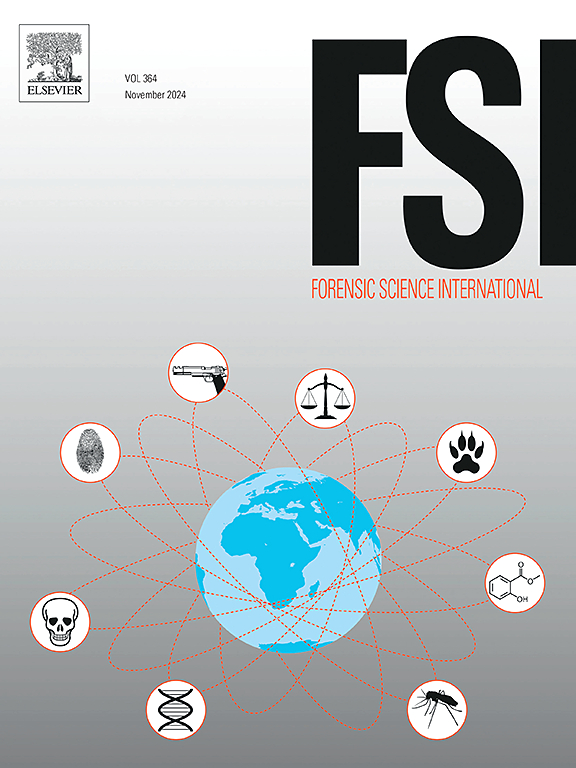重症监护患者死前与死后镇痛、镇静药物血药浓度的比较
IF 2.5
3区 医学
Q1 MEDICINE, LEGAL
引用次数: 0
摘要
重症监护病房(ICU)的患者经常使用镇痛和镇静药物。对于危重病人血液中产生的药物浓度,以及这些浓度在病人死后如何变化,我们所知有限。在本单中心前瞻性研究中,来自普通ICU的死亡患者,目的是描述10种常见镇痛和镇静药物的血药浓度和死后再分布。方法纳入重症监护期间死亡的46例患者。在死前(死前)、死中(死后一小时内)和死后(在停尸房或临床或法医尸检期间通过主动脉弓取样)采集血样。对样品进行了可乐定、右美托咪定、芬太尼、氯胺酮、酮贝酮、吗啡、咪达唑仑、对乙酰氨基酚、异丙酚和硫喷妥钠的分析。结果芬太尼的死后再分布显著,平均浓度从3.1 ng/g增加到5.2 ng/g (p = 0.002)。芬太尼累积剂量和死后时间与死后浓度变化均无相关性。对于其他药物,在死后时间内的变化不显著。中位死前浓度比在较大的ICU患者队列中观察到的浓度高2.3-9 倍。结论在所调查的药物中,只有芬太尼表现出主要的阳性死后再分布,而其他药物的死后变化是不可预测的。我们还得出结论,生者的浓度可能无法与死后不久获得的浓度相比。这些浓度差异,以及观察到的死后变化,可以影响毒理学解释。本文章由计算机程序翻译,如有差异,请以英文原文为准。
Comparison of pre-mortem and post-mortem blood concentrations of analgesic and sedative drugs in intensive care patients
Background
Patients in the intensive care unit (ICU) often receive analgesic and sedative drugs. There is limited knowledge about the resulting drug concentrations in blood in the critically ill patient, and how these concentrations change after death. In this single-centre prospective study of deceased patients from a general ICU, the aim was to describe blood concentrations and post-mortem redistribution for ten common analgesic and sedative drugs.
Methods
We included 46 patients who died during intensive care. Blood samples were collected pre-mortem (before death), peri-mortem (within one hour after death) and post-mortem (through aortic arch sampling at the morgue or during clinical or forensic autopsy). Samples were analysed for clonidine, dexmedetomidine, fentanyl, ketamine, ketobemidone, morphine, midazolam, paracetamol, propofol and thiopental.
Results
Post-mortem redistribution was significant for fentanyl, with a mean concentration increase from 3.1 ng/g to 5.2 ng/g (p = 0.002). There was no correlation between neither cumulative fentanyl dose nor post-mortem interval and post-mortem concentration changes. For the other drugs, the changes during the post-mortem interval were not significant. Median peri-mortem concentrations were 2.3–9 times higher than observed concentrations in a larger cohort of living ICU patients.
Conclusion
In conclusion, of the investigated drugs, only fentanyl showed a predominant positive post-mortem redistribution, whereas for the other drugs, post-mortem changes were unpredictable. We also conclude that concentrations from the living may not be comparable to those obtained even shortly after death. These concentration differences, as well as the observed post-mortem changes, can influence toxicological interpretation.
求助全文
通过发布文献求助,成功后即可免费获取论文全文。
去求助
来源期刊

Forensic science international
医学-医学:法
CiteScore
5.00
自引率
9.10%
发文量
285
审稿时长
49 days
期刊介绍:
Forensic Science International is the flagship journal in the prestigious Forensic Science International family, publishing the most innovative, cutting-edge, and influential contributions across the forensic sciences. Fields include: forensic pathology and histochemistry, chemistry, biochemistry and toxicology, biology, serology, odontology, psychiatry, anthropology, digital forensics, the physical sciences, firearms, and document examination, as well as investigations of value to public health in its broadest sense, and the important marginal area where science and medicine interact with the law.
The journal publishes:
Case Reports
Commentaries
Letters to the Editor
Original Research Papers (Regular Papers)
Rapid Communications
Review Articles
Technical Notes.
 求助内容:
求助内容: 应助结果提醒方式:
应助结果提醒方式:


